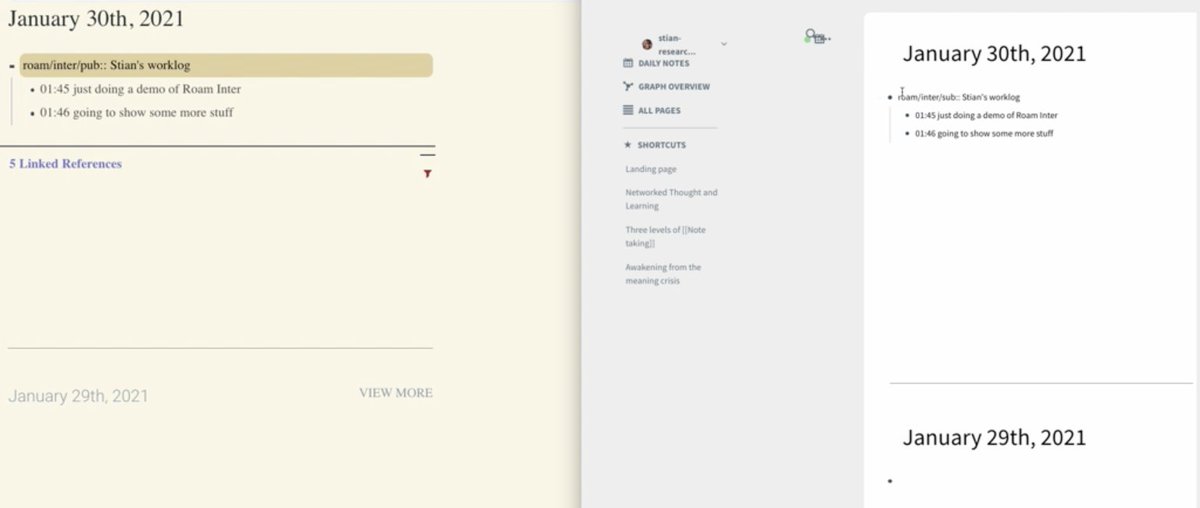
Yesterday @conaw hosted a 2 hr @roamresearch office hour session
There will be a partial recording out, I think, but in the meantime, here are some take-aways for roam/js plugin authors.
https://twitter.com/Conaw/status/1358125760096079873, where he dug into Roam Inter roamresearch.com/#/app/stian-re….
There will be a partial recording out, I think, but in the meantime, here are some take-aways for roam/js plugin authors.
We spent most of the time pairing using Roam Inter (amazingly it mostly worked - although Roam Inter is not really ready for prime time).
The way conversations in Inter are set up mirror how he works with team internally - everyone have their own "space", nested under bullet,
The way conversations in Inter are set up mirror how he works with team internally - everyone have their own "space", nested under bullet,
and they use block-references to communicate - never "write in each others space". They developed the block-reference notification feature for themselves (also seem to have a Slack integration), before they used things like a "Dropzone" (a single bullet you can blockref to ...
get their attention).
He was experimenting in the call with how to show which "incoming questions" he had responded to by block-reffing the block-reference and making it a done TODO, using filters on incoming block-refs (didn't know that was possible).
He was experimenting in the call with how to show which "incoming questions" he had responded to by block-reffing the block-reference and making it a done TODO, using filters on incoming block-refs (didn't know that was possible).
I do funky things with block UIDs, and he did not seem worried about that at all. So creating your own UIDs however should be fine (I use cuid library). However, it is possible to create multiple blocks with the same uid, and this causes crashes...
If you use something like cuid or nanoid, you should be fine, but if there is a risk of importing the same thing twice etc, you should perhaps check first that each id doesn't already exist in the graph (would be nice if the API did this, but alas).
I asked for an event to listen to whenever a new linked reference to a page appears, or a child block to a block is modified etc. This will not come before (maybe) with the new graph structure. For now, running roamAlphaAPI queries on setInterval seems OK to him.
Frequently querying API is not too expensive, since all the data lives in the client. I discussed the need for a diff library that can take a JSON structure and figure out the minimal number of Roam API "moves" to update the graph to fit the JSON structure...
He thinks that this diff algorithm should perhaps be core functionality. But if someone else builds it first, would be great.
I asked about the ability for plugins to store arbitrary metadata in the database (not related to any specific bullets).
I asked about the ability for plugins to store arbitrary metadata in the database (not related to any specific bullets).
He has concerns about file size, someone storing huge blobs etc. Could perhaps make it available to specific plugin authors, or maybe use another storage mechanism (separate Firebase)...
But the idea of writing a simple library that can use an arbitrary page in Roam as a key-value store, just manipulating bullets, and the content of bullets, is one he likes for now.
He likes the idea of enabling plugins to update the username of a block (enabling the unread notifications etc) and will look into it. Tricky part is that the way userids are stored, the graph might not have enough info to render the name on mouseover.
In general, he sees multiuser Roam's as an aberration, and hopes that with proper inter-graph communication, that should not be necessary anymore.
He told us about some fascinating new version control feature, which would let you link from a single bullet to many versions, could also enable things like annotations. It sounds like adding a new "dimension" / primitive to the existing graphs.
He also said he'd announce the winners of the two first #roamgames in the next two days (I guess tomorrow), but that if someone built something that later was built upon in a future RoamGame round, that person would also get a part of the money - encouraging collaboration.
The whole conversation is here roamresearch.com/#/app/Clubhouse (daily page yesterday), although a bit messed up since the extension began misbehaving towards the end (as I said, not ready for primetime)
• • •
Missing some Tweet in this thread? You can try to
force a refresh















